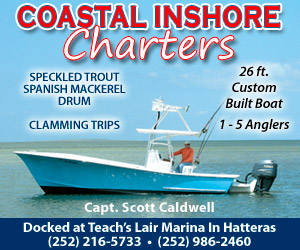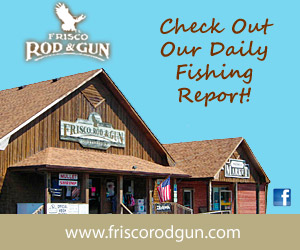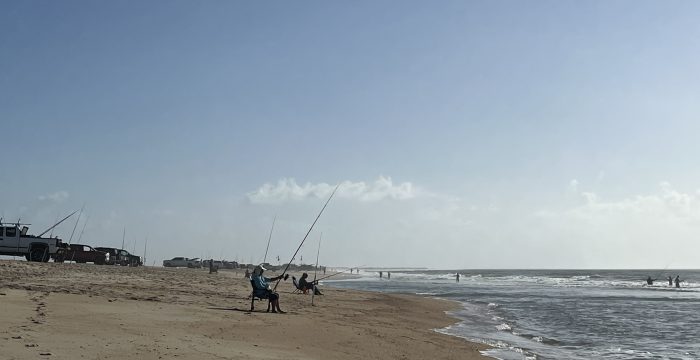
When my husband John and I retired to the Outer Banks of North Carolina, something unexpected happened. I became hooked on surf fishing. Whether casting into crashing waves or calm waters, the anticipation of catching fish was addictive. I watched John for years, as he gathered his gear and headed to the beach; sometimes I’d tag along. One day, I arose from my beach chair and grabbed a pole. Today, after countless failed casts, dropped rods, and the occasional hook mishap, I’m now a fairly-capable surfcaster.
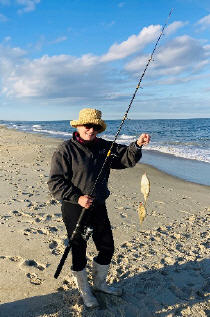
To many fellow anglers’ dismay, we have yet to toss a fish in our cooler. That’s by choice. We’ve caught keeper puppy drum, seatrout, mullet, and bluefish, but John truly enjoys catch-and-release, more than the thought of a free dinner. “We can buy fish at the fish market,” he quips. He’ll cradle beautiful speckled trout in both hands, proudly approach the water’s edge, lean over, and gently release his grip. The trout’s iridescent skin does cast a spell, but I have more of a hunter-gatherer mindset. Locals tell me that fried mullet, also called whiting, is good eating. So, each time I snag a sizable mullet, I turn to John and say, “Can we keep it?” I already know the answer. Indeed, in our sphere, fish live to swim another day.
WHY SURF FISHING?
Surf fishing has much to do with the element of surprise, which is fun. You can spend hours catching nothing, and simply watch dolphins ride the waves, sanderlings dine on small creatures, or seagulls by the thousands chase shrimp trawlers. But a sudden pull on your pole and focus quickly shifts. As you reel in, you try to keep tension on the line and use wave action to help land the fish. You can’t wait to see what emerges from the ocean floor; the anticipation is real. At that moment, you have complete confidence that the big one is coming in. More often than not, you’re left with two stripped-bare hooks. I can hear John now… “That’s why they call it fishing not catching.”
THE EARLY YEARS
While surf fishing is a relatively new pastime for me, I would fish in backyard ponds and the occasional lake as a child. There was something mesmerizing about watching large, yellow- and orange-mottled carp snatch balled-up bread. I’m certain that I caught the same fish over and over again. When vacationing in the Pocono Mountains, we would set off in a canoe, to jig for pickerel. If that doesn’t hook you on fishing, nothing will.
My early experiences as an angler meant that our daughter would also fish one day. Indeed, during our family golf gatherings, we’d awake before dawn to fish. Those ponds held gorgeous, large-mouth bass. It was a true family affair, including grandpop and grandkids. While wrangling children in darkness was never easy, the fish tales we shared at the dinner table were priceless. And hilarious re-enactments of Dan Aykroyd and his Bass-O-Matic (minus the blender and bass) brought down the house.
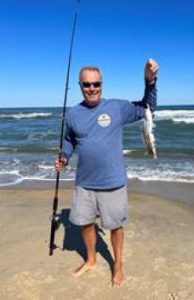
GOING PLACES
Fast forward to fall 2022, and surf fishing on the OBX swings into high gear. That means we’re always in need of rigs and hooks. Next stop: Walmart. As I approach the fishing aisle, I see a woman holding a ring of bottom rigs. Just what I needed. Within minutes of chatting with this friendly woman, Sam, I was invited to join a women’s surf fishing team participating in the largest fishing tournament in the world, on Hatteras Island. I could not wait to tell John!
Held for the past 64 years, the Annual Invitational Surf Fishing Tournament, hosted by the Cape Hatteras Anglers Club, was only one week away. After talking to the team captain, Shirley, I learned that this team event is in the Guinness World Book of Records, and has a 20-year “waiting list” to join. Without hesitation, I said, “I’m in!”
Days of preparation followed, with numerous trips to the tackle shop; I didn’t want to leave anything to chance. By the time I was done, I needed a U-Haul to hold all of my gear. Thankfully, Sam had a Ford F-250 Crew Cab pick-up truck. On November 2, we were on our way. Destination: Frisco, NC, a small village on Hatteras Island that once was the source of lumber for the boat-building trade.
SERIOUS BUSINESS
That evening, from our oceanside rental house, Shirley shared the assigned-station paperwork. In this two-day event, there are two sessions per day – morning and afternoon. Each station is off of a different beach access ramp. With one and a half hours between sessions, there’s plenty of time to have lunch and locate the next ramp.
Before the fun and games could begin, I read the rules of tournament surf fishing. Much goes into the scoring of fish; 50+ roaming judges measure and log any fish that meets the size and species criteria. Most importantly, no one, not even a team member, can help you land a fish. The angler must fight the fish, unassisted, to the beach. I hoped to have such difficulty.
FISHING BY THE NUMBERS
Whether fishing in a tournament or just for fun, the challenge is catching fish.
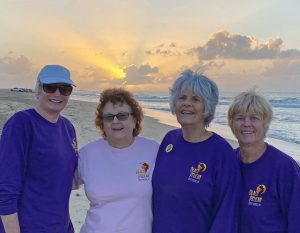
Nov. 4, 2022.
After two days, our four-member women’s team caught only four scorable fish – three sea mullets and one gray trout, for eight points. During the entire tournament, comprised of 111 men’s teams and 17 women’s teams, 1,155 fish were caught, by over 700 anglers.
Day one of the tournament was epic, with wind-driven rain that morning, the likes of which I’ve never seen. Soaked head to toe, we all watched as an enormous thundercloud approached. We weren’t concerned . . . until a lightning bolt landed too close for comfort. One brave soul later re-emerged from her truck, to finish out the session. In contrast to the morning’s apocalyptic conditions, we enjoyed beautiful sunny skies and balmy temps that afternoon. Each of us landed a scorable fish.
Day two was far less eventful; not a single nibble. Despite a dearth of fish, Mother Nature put on a show, with a rainbow forming on the horizon, sea birds diving for fish, and low-tide sandbars providing adventurous anglers with a path to deeper waters. The beauty of Hatteras was not lost in those hours spent waiting and hoping. Even the sight of hundreds of four-wheel vehicles lining the beach was something to behold.
What we didn’t see were anglers pulling in fish. At 4:30 p.m. that gorgeous Friday afternoon, we were officially skunked. That clearly wasn’t the case elsewhere. With fishing stations all across Cape Hatteras National Seashore, there were undoubtedly plenty of pockets, holes, and troughs where fish gathered. The First Place Men’s Division caught 56 fish for 160 points. The First Place Women’s Division caught 13 fish for 38 points.
For details on tournament standings, visit www.capehatterasanglers.club.
TOP 10 TAKEAWA
While we didn’t place in this tournament, I’m optimistic that we’ll have a better showing in our next event on Ocracoke Island in May. I’m looking forward to applying the newfound knowledge shared by my generous and skilled teammates, namely:
- Keep your fishing license handy.
- Invest in high-quality braided line.*
- Change your bait every 10 minutes.**
- Bring a five-gallon bucket with your name on it.
- Rig with circle hooks that fish don’t swallow.
- Have an assortment of different-sized hooks.
- Use snap swivels to easily attach/detach a rig.
- Add a Sputnik sinker to your tacklebox, for strong current.
- Have a sand spike with a pole holder, bait box, and cutting board.
- Bring heavy rain gear – a poncho flapping in the wind doesn’t cut it, as I learned.
* Have a tackle shop string your line, with 20-lb. test; make sure they use monofilament backing.
** Advice from the late surf fishing legend Lance Newman, Nags Head. “Fish don’t like soaked bait.”
After spending two days alongside experienced saltwater anglers, I’m confident that I can now hold my own. From rigging the pole, which I had never done, to cutting fresh bait fish, I’ve acquired tangible skills. John no longer needs to bait my hook, even with bloodworms; they bite, you know. Also, he’s no longer asked to remove a fish from my hook. I suspect that he’s very pleased I made the trip to Hatteras.




